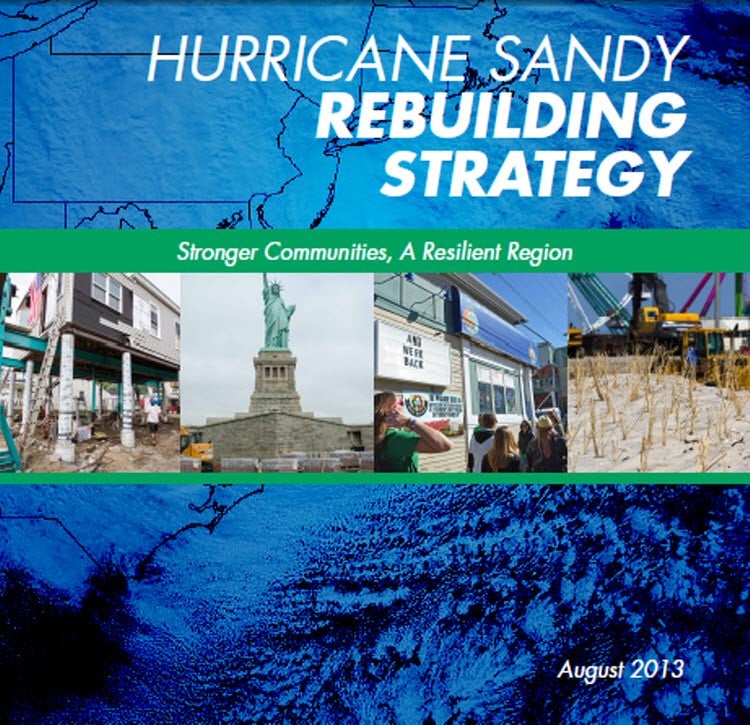How Smarter, More Flexible Energy Can Help Communities Weather Future Storms
 Last week, the Hurricane Sandy Rebuilding Task Force released a Rebuilding Strategy, which aims to rebuild communities affected by Hurricane Sandy in ways that are “better able to withstand future storms and other risks posed by climate change.” From an energy perspective, the main goal of these recommendations is to make the electrical grid smarter and more flexible. This effort would minimize power outages and fuel shortages in the event of similar emergency situations in the future.
Last week, the Hurricane Sandy Rebuilding Task Force released a Rebuilding Strategy, which aims to rebuild communities affected by Hurricane Sandy in ways that are “better able to withstand future storms and other risks posed by climate change.” From an energy perspective, the main goal of these recommendations is to make the electrical grid smarter and more flexible. This effort would minimize power outages and fuel shortages in the event of similar emergency situations in the future.
The Task Force is led by President Obama and chaired by Housing and Urban Development (HUD) Secretary Shaun Donovan. The recommendations put forth in the report were developed with Governor Cuomo, Governor Christie, and a number of federal agencies and officials from across New York and New Jersey, representing an unusual opportunity to make changes that will help communities weather future crises.
This key idea – smarter, flexible energy – is central to resilience, safety and quick recovery in a storm, as well as reducing the harmful pollution linked to climate change in the first place. This has been a key theme of EDF’s efforts to help the Northeast region respond to Sandy.
When the power grid went down on most of New York City following Hurricane Sandy, a number of buildings were able to keep their lights on thanks to existing microgrids and on-site, renewable energy sources. The Task Force report lays out a path forward for taking these isolated success stories to scale and making these clean technologies available to everyone.
It is also essential for electric utilities to invest in technologies, like sensors and modernized digital meters, which give quick feedback about outages and enable fast response and transparent customer communications. These technologies and policy solutions enable improved customer service and a wider range of options for customers. Good examples include innovative ideas like TXU Energy’s ‘Free Nights’ in Texas, which offers customers free energy rates between 10pm and 6am (when the wind happens to blow the hardest), and the ability to manage the power grid where critically-important infrastructure like hospitals and school-based shelters can “island” themselves in a crisis. These ‘microgrids’ also make it easier for utilities to manage an electricity network that takes full advantage of the technical potential of cleaner energy sources like solar and wind.
EDF’s smart power experts are already deployed in the thicket of utility regulation to help accomplish these goals. Along with many partners, we’re ramping up in New York and New Jersey – and it’s not only helpful, but also inspiring, to add the Task Force’s wind to our sails as we work through the challenge of taking big ideas like these and helping to translate them into effective regulation.
The HUD strategy report also recognizes a key insight that is often overlooked in the esoteric, wonky debates about energy regulatory policy: the vast potential, and therefore need, for energy resiliency occurs in our homes, offices, schools and public buildings – in other words, in the buildings that we use every day, in the way our neighborhoods are built, in things that we see and touch at home and work all the time.
For example, the report calls for smart recovery steps to make “housing units – both individual and multi-family – more sustainable and resilient.” One idea put forth recommends that mortgages and insurance plans should offer affordable energy upgrades and one-stop shops for clean, distributed, customer-side energy resources.
EDF, too, is advancing ideas like on-bill-repayment to create an easy path for energy efficiency upgrades to be financed with both private and public capital. Efficiency, solar and other renewables create financial savings for customers that open the door to financing, because they pay for themselves over time. Our Investor Confidence Project offers a template for making those energy savings transparent and bankable to the investment community.
Responding to a crisis like Hurricane Sandy is in many ways a complex exercise in connecting the dots across policy, finance and infrastructure. Envisioning what all this looks like can be a challenge, and I’m excited that HUD has partnered with the Van Alen Institute (disclaimer: I’m a trustee there) and other civic groups to launch a competition for energy-resilient, post-Sandy designs. It’s time to connect the dots between energy regulation, resilience and what we need to be safe and secure, in ways that celebrate our great communities, cities and coastlines.
Fortunately, these steps by the Task Force are a great start.










